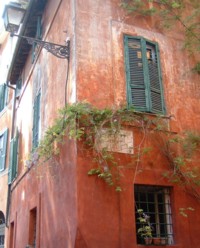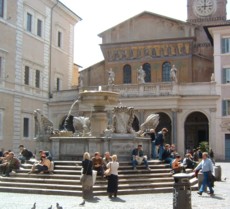Trastevere is a picturesque medieval area located on the west bank of the Tiber. The area escaped the grand developments which changed the face of central Rome, and is a charming place to wander, eat or relax.

Trastevere (TrasTEVeh-ray)is named for its position ‘over the Tiber’. Separated from the heart of central Rome by the river, the area retained its narrow lanes and working-class population when the rest of Rome began its nineteenth-century expansion.
Tourists are charmed by Trastevere, although they descend in numbers which slightly obscure the area’s personality. From being the last surviving pocket of earthy medieval Rome, the neighbourhood has also become unique in Rome in attracting a crowd of young crusty-locked foreign beggars, buskers and alcoholics. Internet cafes are side-by-side with gloomy ancient premises of uncertain function, and you can choose from trendy bars and traditional chocolate shops. Still, despite the influx of foreign money, Trastevere still maintains a strong local identity
The heart of Trastevere is Piazza di Santa Maria in Trastevere, a pedestrianised square piazza lined with restaurants and pricey bars, faded palazzi, and the church of Santa Maria in Trastevere. The steps surrounding the pretty central fountain are a popular hang-out spot for a non-typical crowd (watch out for unwashed jugglers).
Heading up the lane to the right of the church, and choosing one of the right-hand turnings, you enter into the maze of narrow lanes at Trastevere’s heart. Plants scramble down walls from garden terraces, washing hangs out to dry, and chipped Virgin Marys look down from shrines on street corners.
The streets close to the river and south of Viale Trastevere are much quieter and there are several unpretentious restaurants where you can enjoy a peaceful meal at an outdoors table. The church of Santa Cecilia in Trastevere is one of Rome’s more interesting churches. The statue by the altar is based on the body of the patron saint of music, martyred St. Cecilia, which was found undecayed in her coffin in the sixteenth-century. From here, it’s a short walk to visit the Isola Tiberina (Tiber Island).

There are lovely lanes to explore, and it’s not too difficult to step off the main routes and escape the masses. As well as the occasional touch of authentic local colour, there are plenty of businesses aimed at the large foreign population (strongly American and French). Rome’s principal foreign-language cinema is located here, as well as countless restaurants, popular with both Romans and tourists. There are also lots of stylish bars – most are fairly new, but still atmospheric. It’s a lovely area to wander in the soft dark of a Roman evening, with a more intimate feel than the palazzi-filled Centro Storico.
Trastevere is a short walk from Largo Argentina in the Centro Storico – alternatively you can take tram number 8, and descend at the first stop over the Tiber. There’s no Metro station nearby.
Trastevere highlights
Walk: Walk to Trastevere from Campo dei Fiori over the elegant pedestrian bridge, Ponte Sisto, roam the tourist streets north of Viale Trastevere and the quieter lanes to the south.
Take-away food: Enjoy a slice of pizza from the excellent tavola calda at Piazza Trilussa, a popular meeting point.
Ice cream: Follow your meal or cinema trip with an ice cream from the Gelateria alla Scala (try the cinammon flavour: canella).
Pizzeria: Dar Poeta on Vicolo del Bologna is a Roman favourite.
Restaurant – bar – pizzeria: Ristorante Alla Scala (Piazza della Scala) has a wide-ranging menu in a prime people-watching location.
Trattoria: We recommend the pasta ai fiori di zucca at the Antica Trattoria Da Carlone, Via della Luce, 5.
Gardens: The Orto Botanico is Rome’s attractive botanical garden.
On this site